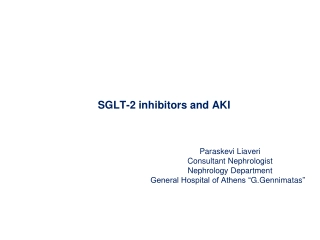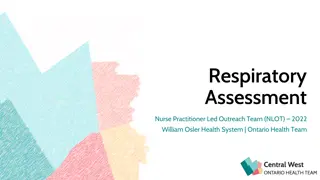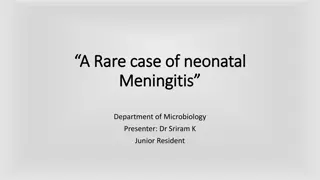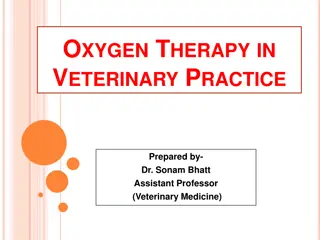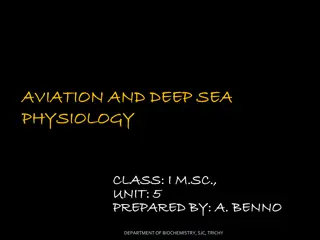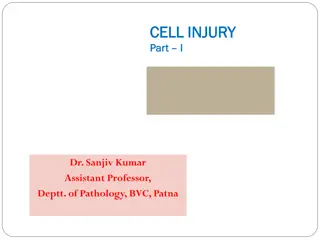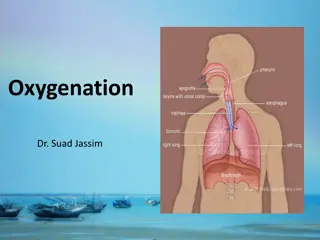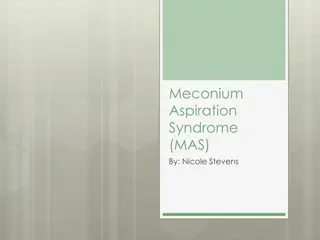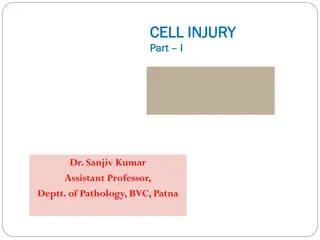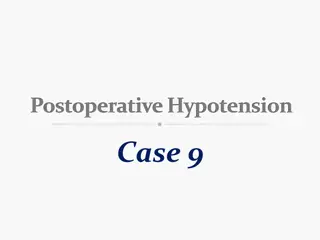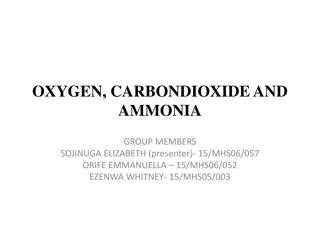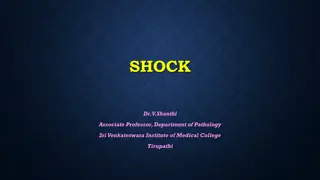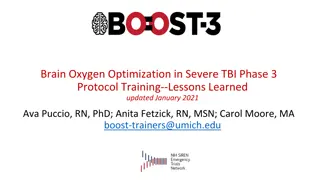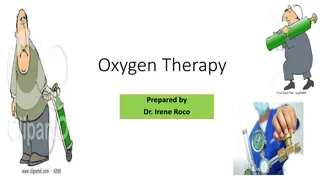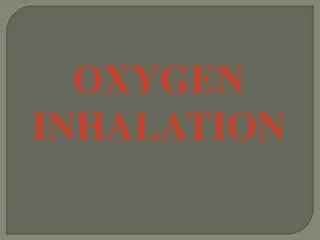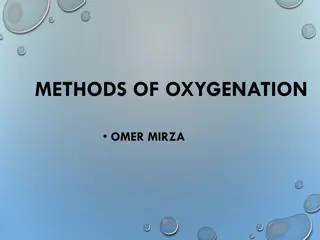SGLT-2 inhibitors and AKI
Consultant Nephrologist Paraskevi Liaveri discusses the association between SGLT-2 inhibitors and acute kidney injury (AKI). Pharmacovigilance reports highlight a higher risk of AKI with these drugs, especially when combined with RAAS blockers, diuretics, or NSAIDs. Studies suggest potential mechani
0 views • 49 slides
Regulation of Energy Homeostasis by AMPK System and Its Modulation Factors
The AMPK system plays a crucial role in regulating energy homeostasis by sensing the cellular AMP:ATP ratio and responding to metabolic stresses that affect ATP production or consumption. AMPK is activated by factors such as hypoxia, glucose deprivation, and metabolic inhibitors, as well as by compo
0 views • 27 slides
Respiratory Assessment
Conducting a thorough respiratory assessment is crucial in detecting early signs of deterioration in patients. This guide covers the key aspects of respiratory assessment, including assessing breathing, identifying different types of hypoxia, indications for assessment, pulse oximetry, visual and ta
0 views • 25 slides
Understanding Shock and Blood Transfusion in Surgery
Shock is a state of low tissue perfusion leading to metabolic changes like anaerobic metabolism and acidosis. As cellular hypoxia progresses, immune and coagulation responses are activated, impacting cardiovascular, respiratory, renal, and endocrine systems. Shock can be classified into hypovolaemic
0 views • 38 slides
Rare Case of Neonatal Meningitis with Antibiotic Challenge
A term male baby born with perinatal hypoxia developed neonatal meningitis with convulsions. Blood culture revealed Acinetobacter sp. and Pseudomonas sp. Empirical antibiotic therapy was escalated to Colistin and Ceftazidime due to resistance. Subsequent testing showed colonies resembling Pseudomona
0 views • 17 slides
Oxygen Therapy in Veterinary Practice
Oxygen therapy is a crucial intervention in veterinary medicine, especially in emergency situations to address hypoxia and increase oxygen delivery to tissues. It involves delivering high concentrations of oxygen to optimize oxygen levels in the blood. Indications for oxygen therapy include hypoxia
1 views • 15 slides
High-Altitude Physiology and Its Effects on the Human Body
Understanding the impact of high altitudes on human physiology is crucial for aviation and deep-sea activities. Barometric pressures and alveolar oxygen levels change significantly with altitude, leading to hypoxia-related issues. Factors like carbon dioxide and water vapor further affect alveolar o
1 views • 29 slides
Understanding Cell Injury and Adaptation in Pathology
Rudolph Virchow's concept of disease starting at the cellular level highlights how cells constantly face challenges in maintaining homeostasis. The plasma membrane acts as a barrier against external stressors, but when cells face excessive physiological stresses or pathological stimuli, they adapt o
0 views • 16 slides
Understanding Oxygenation and Respiratory System Function
Explore essential terms like alveoli, perfusion, atelectasis, and more in the context of respiratory system function. Learn about lung anatomy, oxygenation processes, and common respiratory disorders like dyspnea and hypoxia. Discover the crucial factors for maintaining normal respiratory function.
0 views • 35 slides
Addressing Ocean Hypoxia Through Innovative Solutions
Reversing ocean hypoxia requires a paradigm shift towards cyclic nutrient use, increased efficiency in fertilizer use, and enhanced nutrient recovery from waste. The socioeconomic impacts of excess nutrients on marine ecosystems are substantial, highlighting the need for new partnerships and technol
0 views • 8 slides
Climate Impacts on the U.S. West Coast: Insights and Challenges
Climate impacts on the U.S. West Coast, including marine heat waves, species range shifts, hypoxia, ocean acidification, harmful algal blooms, sea level rise, and coastal erosion. Insights from experts like Jan Newton, NANOOS Director, highlight the significance of monitoring and addressing these en
0 views • 9 slides
Understanding Meconium Aspiration Syndrome (MAS) in Newborns
Meconium Aspiration Syndrome (MAS) is a condition where a newborn aspirates meconium, the first substance discharged from the GI tract. This primarily affects term or post-term infants and can lead to airway obstruction, gas trapping, chemical pneumonitis, and PPHN. Risk factors include hypoxia and
0 views • 31 slides
Understanding Cell Injury and Degeneration in Response to Various Stressors
Cell injury can result from multiple stressors such as hypoxia, physical agents, chemicals, microbes, immunologic factors, nutritional imbalances, and aging. This can lead to reversible changes (degeneration) or irreversible changes (necrosis). Types of degeneration include cloudy swelling, hydropic
0 views • 22 slides
Understanding Cell Injury and its Causes in Pathology
Rudolph Virchow's concept of disease starting at the cellular level is explored in this content, focusing on the impact of the external environment on cell equilibrium. The role of the plasma membrane as a barrier and the definitions of normal cell function, adaptation, reversible injury, irreversib
0 views • 16 slides
Iowa Nutrient Pollution Control Measures and Strategies
Gulf Restoration Network Decision, sources of Nutrients Nitrogen (N) and Phosphorus (P), impacts of Nutrient Pollution leading to Algae Blooms and Gulf Hypoxia (Dead Zone), measures to reduce Non-Point Source (NPS) contamination, EPA's current strategy, and Iowa's approach with its Nutrient Reductio
0 views • 20 slides
Pulmonary Abnormalities and Their Physiologic Effects
Chronic pulmonary emphysema is a complex obstructive and destructive lung condition typically caused by smoking. It leads to chronic infection, excessive mucus production, airway obstruction, and lung tissue destruction. The physiological effects of emphysema include hypoxia, hypercapnia, and severe
0 views • 12 slides
Postoperative Hypotension: Management and Recovery Strategies
In a case of postoperative hypotension following a transurethral prostatectomy under spinal anesthesia, a 78-year-old patient presented with agitation and shivering in the PACU. Vital signs and pain scores were monitored, showing a blood pressure of 89/40, heart rate of 85/min, and respiratory rate
0 views • 16 slides
Understanding Oxygen: Uses, Effects, and Importance in Living Organisms
Oxygen, a vital nonmetallic element, plays a crucial role in various processes essential for living organisms. It is involved in energy production, metabolism, immune system support, and more. However, the lack of oxygen can lead to serious conditions like hypoxia. Learn about the uses, effects, and
0 views • 37 slides
Understanding Shock: Types, Mechanisms, and Pathophysiology
Shock, a state of systemic hypotension resulting in impaired tissue perfusion and cellular hypoxia, has various types such as cardiogenic, hypovolemic, septic, neurogenic, and anaphylactic shock. Each type has different mechanisms and causes, leading to decreased cardiac output and multiorgan failur
0 views • 45 slides
Understanding Haemodynamic Consequences of Acute Pulmonary Embolism
Haemodynamic consequences of acute pulmonary embolism (PE) include increased mean pulmonary artery pressure, rise in right ventricular preload and end-diastolic pressure, risk of right ventricular failure, and decreased pulmonary blood flow leading to low systolic blood pressure. Arterial hypoxia ca
0 views • 18 slides
Oregon Conservation and Recreation Fund Advisory Committee Meeting - January 10th, 2024
The Oregon Conservation and Recreation Fund Advisory Committee held a virtual meeting on January 10th, 2024. The agenda included reviewing and approving meeting minutes, a guest presentation on ocean acidification, hypoxia, budgeting, and RFP determinations for 2024. Lessons learned from past OCRF s
0 views • 19 slides
Lessons Learned in Brain Oxygen Optimization for Severe TBI Phase 3 Protocol
Screening, enrollment, and inclusion/exclusion criteria insights for the Brain Oxygen Optimization in Severe Traumatic Brain Injury (TBI) Phase 3 Protocol are discussed. Key points include handling urgent patient queries, guidelines on hypotension and hypoxia, pupil assessment considerations, and su
0 views • 20 slides
Comprehensive Guide to Oxygen Therapy and Safety Precautions
Oxygen therapy is a crucial medical intervention for various conditions, such as hypoxia, impaired gas exchange, and heart failure. This guide covers the administration of oxygen, types of oxygen supply, safety precautions, and devices used for oxygen delivery. Safety measures include avoiding smoki
0 views • 16 slides
Understanding Oxygen Inhalation in Medical Treatment
Oxygen inhalation is a vital medical intervention to treat low blood oxygen levels in children with respiratory issues. It helps manage hypoxia, maintain oxygen levels in the blood, and support normal cellular function. Common indications include cyanosis, breathlessness, anemia, and exposure to low
0 views • 44 slides
Comprehensive Guide to Oxygenation in Respiratory Care
Oxygenation is a vital aspect of medical care, involving the process of delivering oxygen to the body's cells. It includes measures such as Arterial Oxygen Saturation, Oxygen Delivery, Oxygen Consumption, and Oxygen Extraction. Understanding hypoxia and hypoxemia, as well as the mechanisms of hypoxe
0 views • 28 slides
